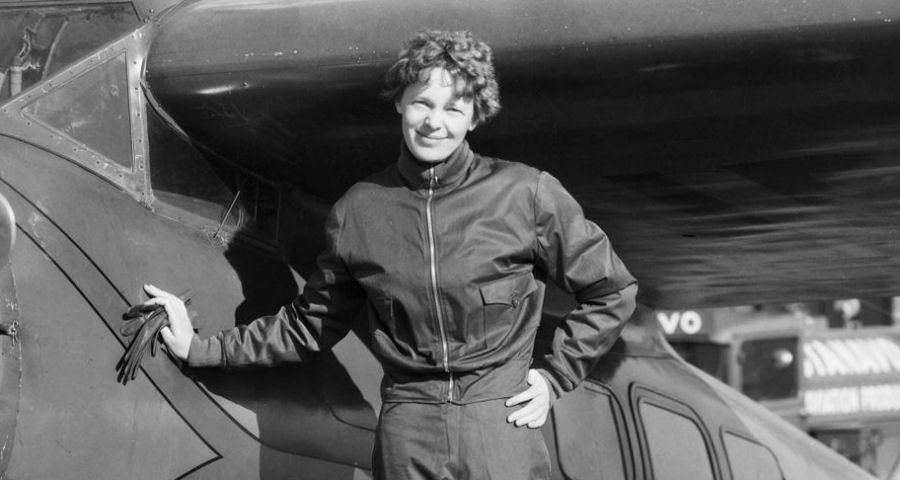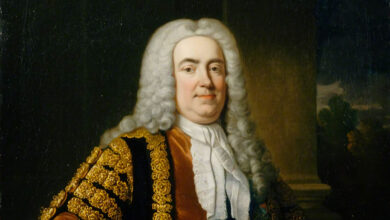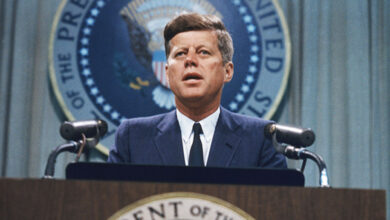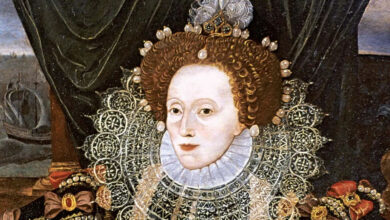
Podcast: Play in new window | Download
Subscribe: Spotify | Amazon Music | Youtube Music | RSS
Born on 24 July 1897 at her grandfather’s home in Atchison, Kansas, Amelia Mary Earhart was the daughter of Samuel Stanton Earhart, a claims officer for the Rock Island Railroad and his wife Amy. She grew up with her sister Grace Muriel Earhart, who was affectionately known as Pidge and was two years Amelia’s junior with the two of them known to regularly go off exploring around their local neighbourhood, climbing trees and even hunting rats with a rifle.
In 1904 at the age of around 7, Amelia, with her uncle’s help, fixed a home-made ramp to the roof of the tool shed. Using a wooden box as a sled, Amelia described her first trip off the end of the ramp to her sister as “just like flying” even though up to that point she had never seen an aircraft.
That changed though after her father was transferred to Des Moines in Iowa in 1907, although the children didn’t move there permanently until 1909. During the intervening period, the girls were homeschooled by their mother with the help of a governess and Amelia remembered being very fond of reading lots of books in the family library where she spent many hours. When they did join their parents in Des Moines, it would be the first time that the two sisters received any formal education, with Amelia Earhart entering the seventh grade at the age of 12.
Amelia Earhart saw her first aircraft at the 1907 Iowa State Fair and Amelia’s father tried and failed to get the two sisters to take a ride but Amelia was more interested in the merry-go-round, describing the rickety old biplane as “a thing of rusty wire and wood and not at all interesting.”
Although finances seemed to be improving following the move to Des Moines, things took a turn for the worst as Edwin’s drinking turned into alcoholism and this led to him being forced to retire in 1914. He intended to recover from his addiction and sought treatment, but the railroad wouldn’t have him back. Around the same time, Amelia Earhart’s grandmother Amelia Otis died leaving a considerable estate that was put into trust to protect it from Edwin’s drinking. Amelia described this period of her life as the end of her childhood as the Otis house and contents were sold off.
Following an attempt by Edwin to return to work, a proposed move to Springfield, Missouri came to nothing and so Amy took the two girls to live with friends in Chicago where Amelia eventually enrolled at High Park High School as it had the best to offer in terms of its science classes, which Amelia had expressed an interest in but unfortunately her time there wasn’t a happy one. Amelia Earhart graduated in 1916 and started to look up to women who had found success in predominantly male roles, keeping a scrapbook about their exploits in fields such as mechanical engineering, law and film production.
Although Amelia Earhart began a college course at the Ogontz School in Rydal, Pennsylvania, she soon dropped out and visited her sister in Toronto during Christmas 1917 where she witnessed wounded soldiers returning home from war. This moved her to train as a nurse’s aide with the Red Cross and began working at the Spadina Military Hospital in Toronto where she prepared food and handed out prescription medication.
As the Spanish Flu took hold in 1918 and reached Toronto, Amelia Earhart’s nursing duties became more intensive but this ultimately led to her being hospitalised herself suffering from pneumonia and sinusitis. She underwent a number of small operations designed to resolve the sinusitis problem which were unsuccessful and she would suffer symptoms for the rest of her life.
During the next two years, Amelia Earhart came across aviation on two particular occasions. The first was when she visited an airfield with a friend and the second was in Long Beach in 1920 when she visited an airfield with her father. It was at this second visit that Amelia experienced her first flight when she was taken aloft by the World War I ace Frank Hawks. She was immediately hooked and became determined to learn how to fly.
She started earning money by taking whatever jobs she could find including as a truck driver, photographer and stenographer and saved up the $1000 needed for lessons, the first of which she took on 3 January 1921 with Anita Snook in a Curtiss JN-4, known as a Canuck. Six months later Amelia Earhart acquired her first plane which was a bright yellow Kinner Airster biplane which she called The Canary. Not long after she set a new world altitude record for a female pilot when she took The Canary to 14,000 feet. She earned her pilot’s licence on 15 May 1923, becoming only the 16th woman to do so.
Unfortunately, the following year, the money that had been left to her mother dwindled away to nothing following some unsuccessful investments resulting in Amelia having to sell her plane. She found employment as a teacher and then a social worker in 1925 Boston although she lived in Medford, Massachusetts. Amelia Earhart’s interest in aviation didn’t go away though and as she became more financially stable, she took an interest in operations at Dennison Airport in Quincy, Massachusetts, from where she flew the first official flight in 1927.
Amelia started to become somewhat of a local celebrity as she wrote columns in the local newspaper promoting flying, especially flying that involved female pilots. This led to her receiving an offer to accompany pilot Wilmer Stultz on a trans-Atlantic flight with her duty being to keep the flight log. The flight was successful, taking off from Newfoundland on 17 June 1928, landing 20 hours and 40 minutes later in South Wales in the United Kingdom. Although she never took the controls of the aircraft during the flight, Amelia Earhart became the first woman to fly nonstop across the Atlantic and so when the flyers returned home they received a ticker-tape parade in Manhattan followed by a meeting with President Calvin Coolidge at The White House.
Amelia Earhart became an instant celebrity, something that she embraced, using her image to promote female aviation and through celebrity endorsements of various products including women’s fashions and a luggage line she was able to finance her own flying. She even became an associate editor of Cosmopolitan magazine and with Charles Lindbergh, she promoted the development of commercial air travel through the representation of Transcontinental Air Transport, later TWA. Soon after, she became Vice President of National Airways which by 1940 had become Northeast Airlines.
During this time Amelia Earhart was also embarking on record-setting achievements of her own, including flying across the North American continent and back in August 1928, taking part in competitive air racing in 1929 and setting a new world altitude record in 1931 when she flew a Pitcairn PCA-2 to 18,415 feet. In the same year as setting this new record, Amelia also married George P. Putnam who had sought her out following his divorce in 1929. It took six proposals from him before Amelia eventually agreed to the union. The couple never had any children of their own but she was known to be fond of George’s two boys, David and George from his previous marriage.
In 1932, Amelia Earhart planned a solo non-stop flight across the Atlantic to Paris, intended to emulate Charles Lindbergh’s historic flight. Although poor weather conditions meant that she didn’t reach Paris, she did become the first female aviator to fly non-stop across the Atlantic when she landed in Derry, Northern Ireland, 14 hours and 56 minutes since taking off in Newfoundland. As recognition of her achievement, congress awarded her the Distinguished Flying Cross. The French government awarded her the Cross of Knight of the Legion of Honor and the National Geographic Society awarded her a gold medal.
More solo flights followed, including from Hawaii to California in January 1935, and from Los Angeles to Mexico City and from Mexico City to New York later the same year. The next item on her list of things to do in an aircraft would take her to the next level in aviation record-setting…… a circumnavigation of the world, planning for which started in early 1936.
The flight would be one of 29,000 miles and would need to be undertaken in a new aircraft as her trusty old Vega simply wasn’t up to the job. Consequently, a Lockheed Electra 10E was built to Amelia Earhart’s own specifications by the Lockheed Aircraft Company at its Burbank plant in California near to where Amelia and her husband had recently relocated following a fire at their previous home in Rye, New York.
The first attempt at the trip was undertaken on 17 March 1937 when Amelia and her crew which included an experienced navigator called Fred Noonan, took off from Oakland, California, heading for Honolulu, Hawaii. Following some servicing work that needed to be carried out on the Electra in Hawaii, the second leg of the flight began, with the intention of heading towards Howland Island in the Pacific. However, the flight never got off the ground when the nose wheel collapsed causing both propellers to hit the ground resulting in significant damage to the aircraft.
The second attempt was undertaken in the opposite direction to the first due to some changes in global wind and weather patterns. The first leg from Oakland to Miami was unpublicised but upon arrival in Florida, Amelia Earhart announced her intentions to circumnavigate the globe.
Earhart and Noonan set off from Miami on 1 June 1937 and arrived in Lae, New Guinea on 29 June after a number of stops in various places in South America, India and Southeast Asia. At this point, the pair had completed 22,000 of the 29,000-mile journey with the remainder to be completed across the Pacific Ocean.
This next leg began on 2 July 1937 within the intended destination being Howland Island which was just over 2500 miles away. Early in the afternoon of the same day, Amelia reported that her altitude was 10000 feet but that she was going to reduce altitude due to thick cloud. Two hours later, she reported that she was flying at 7000 feet at 150 knots. Her last known position was around 800 miles into the flight near the Nukumanu Islands.
A search for Amelia Earhart and Noonan began within an hour of their last transmission, with the United States Navy adding resources over the next three days, culminating in the battleship Colorado taking over search operations on the fourth day, 6 July 1937. The official search lasted for a further 13 days and cost upwards of $4m, the most intensive and costly in U.S. Navy history up to that point. George Putnam subsequently financed a private search of nearby islands but no trace of the Electra or its two occupants was ever found. Since the disappearance, there have been several theories as to what happened with probably the most likely being that the aircraft ditched at sea after running out of fuel due to navigation errors. However, other theories include that the pair landed on nearby Gardner Island, or were captured by the Japanese. Amelia Earhart was declared legally dead on 5 January 1939.
Podcast: Play in new window | Download
Subscribe: Spotify | Amazon Music | Youtube Music | RSS




